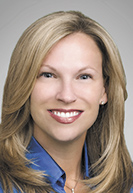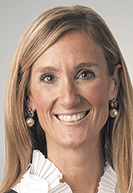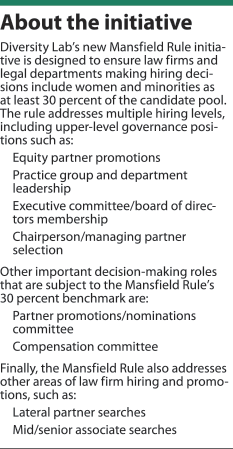Subscriber Benefit
As a subscriber you can listen to articles at work, in the car, or while you work out. Subscribe NowIn 2003, the National Football League established a policy requiring all teams to interview at least one minority candidate for high-level coaching and team operations jobs. Today, the legal community is putting its own spin on the “Rooney Rule,” named after Dan Rooney, former owner of the Pittsburgh Steelers and then-chairman of the league’s diversity committee, by piloting a new initiative designed to ensure the pipeline to law firm leadership positions contains a diverse pool of candidates.
Born of Diversity Lab’s 2016 Women in Law Hackathon, the new initiative known as the “Mansfield Rule” uses a data-driven approach to ensure participating firms actively consider women and minorities for open positions when making hiring decisions, including making selections for promotions, lateral hires and law firm governance positions. Thirty percent of a candidate pool must be women and minorities under the rule. Bearing the name of Arabella Mansfield, the first woman admitted to the practice of law in the United States, the Mansfield Rule initiative requires law firms to intentionally track the applicants they consider in the hiring process to ensure the pipeline into law firm leadership includes candidates from as many backgrounds as possible.
 Stacy
Stacy“It’s the Rooney Rule on steroids,” said Caren Ulrich Stacy, Diversity Lab founder and CEO.
From idea to initiative
Diversity Lab’s Women in Law Hackathon, held at Stanford University in June 2016, was a competition styled after the reality TV series “Shark Tank.” The competition brought together 54 law firm leaders from across the country and tasked them with developing initiatives that promote the advancement of women in the law.br />
Nina Markey, a shareholder in Littler Mendelson P.C.’s Philadelphia office, was on the team of leaders who came up with the Mansfield Rule idea. Markey and her team wanted to develop a concept that would be easy for law firms to implement, yet would still be impactful toward the goal of advancing women in the law. With the original Rooney Rule in mind, they pitched an idea that would require law firms to be intentional in their selection of a diverse applicant pool when making hiring decisions.
 Markey
MarkeyThe Hackathon judges didn’t select the Mansfield Rule as a winning pitch, but the concept was able to come to fruition after being selected as a fan favorite idea. While the original pitch focused on the promotion of women in the law, the implementation of the Mansfield Rule expanded the concept to also include minority attorneys.
The combination of simplicity and impact is what made the Mansfield Rule appeal to the Hackathon participants and caused them to throw their support behind the idea, Stacy said. Specifically, Markey said the 30 percent benchmark is easy to measure, yet is a large enough number to effectuate real change toward a more diverse pipeline.
Inter-firm collaboration
 Horvath
HorvathWomen and minorities have a long history of being underrepresented in the legal profession, prompting research into the reasons why as well as possible remedies, said Brita Horvath, director of diversity and inclusion for Faegre Baker Daniels LLP, one of 44 participating firms and legal departments that are changing their recruiting practices to try to reach the 30 percent benchmark. She said the Mansfield Rule stands apart from prior efforts because all the participating firms are collaborating with the goal of creating a more diverse legal pipeline.
That inter-firm collaboration was not an original tenet of the concept Markey and her team pitched at the Hackathon, Horvath said, but rather has developed naturally and out of necessity.
Each participating firm is unique and has its own internal hiring process, which means there is no uniform way of reaching the 30 percent goal, she explained.
That’s why the firms began participating in “knowledge sharing calls,” or conference calls that allow the participants to share what is working for them as they try to implement the Mansfield Rule, and to ask for ideas when they are struggling. The process of physically tracking the number of women or minority applicants has been one of the biggest challenges for participating firms, Stacy said.
 Herz
HerzKaren Herz, Littler’s senior director of attorney recruiting and development, agreed, noting that before the rule, she had never taken the time to intentionally keep track of what the pool of applicants looked like. Now, Herz and other Littler attorneys involved in the hiring process take several looks at their applicant lists to ensure a sufficient number of women and minorities are represented. The firm usually has a sufficiently diverse candidate pool, Herz said, but she still reviews that pool to ensure no groups are underrepresented.
Likewise, Horvath said Faegre has historically been above national averages in terms of women in leadership positions, so participation in the Mansfield Rule has helped the firm to improve upon its existing efforts.
“With diversity and inclusion, there’s a certain amount of an understandably subjective approach,” Horvath said. “With this particular initiative, it’s data-driven, so it sort of makes it more objective. … It’s measurable and there’s a method, and I think that has a lot of appeal and attraction.”
 The collaborative portion of the Mansfield Rule’s method is its most attractive feature, Horvath said. For example, during a recent knowledge sharing call, the participating firms learned about writing gender-neutral job postings, a topic that opened Horvath’s eyes to best practices for ensuring job announcements appeal to applicants from all backgrounds. She found that information to be particularly relevant to openings for lateral hires, which would be posted internally and externally to the broader legal community.
The collaborative portion of the Mansfield Rule’s method is its most attractive feature, Horvath said. For example, during a recent knowledge sharing call, the participating firms learned about writing gender-neutral job postings, a topic that opened Horvath’s eyes to best practices for ensuring job announcements appeal to applicants from all backgrounds. She found that information to be particularly relevant to openings for lateral hires, which would be posted internally and externally to the broader legal community.
Experts from various industries also participate in these calls to share their perspectives on the diversity promotion tactics that are successful in their line of work, Stacy said.
For example, technology professionals recently spoke on the benefits of strategies such as blind resume reviews and interviews, which can minimize unconscious biases.
“We’re trying to give them as much support and knowledge sharing as we can give them to diversify their pipeline,” she said.
Future success?
As the Mansfield Rule has been rolled out across the country, there’s been one common thread running through each office: internal support from attorneys.
That support has come as a pleasant surprise in some instances, Stacy said, because there was some concern about attorneys who might be skeptical of whether the initiative could work. But so far, the skeptics have been silenced as attorneys witness the simple process of tracking applicants and being intentional when seeking diversity in candidate pools, the Diversity Lab CEO said.
Looking toward the future, the attorneys anticipate the Mansfield Rule will succeed beyond its initial pilot year as firms begin to view the initiative as an opportunity to take much-needed steps toward diversifying their practices.
“We’ve had (44) of the biggest and best law firms who, right out of the gate, signed on knowing what it meant, but only with a rough outline,” Markey said. “They were signing on pretty blindly, and that’s a testament to how much this is needed and that firms are looking for ways to improve these efforts.”
Aside from Faegre and Littler, two other participants have Indiana ties: Brinks Gilson & Lione, which has an Indianapolis office, and Salesforce’s legal department.•
Please enable JavaScript to view this content.
